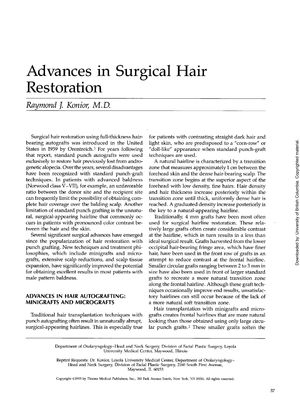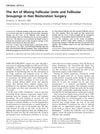Advances in Surgical Hair Restoration
January 1993
in “
Facial Plastic Surgery
”

TLDR Surgical hair restoration has improved since 1959, with new techniques like minigrafts, micrografts, and scalp reductions creating more natural hairlines and reducing bald skin, despite some risks and potential for scarring.
In 1992, surgical hair restoration had improved significantly since the introduction of full-thickness hair-bearing autografts in 1959. The standard punch autografts had several disadvantages, including limitations in patients with advanced baldness and unnatural hairlines. New techniques such as minigrafts and micrografts, extensive scalp reductions, and scalp tissue expansion were introduced. Minigrafts and micrografts, containing three to six hairs and one or two hairs respectively, created more natural-looking frontal hairlines. Scalp reduction techniques allowed for a greater excision of bald skin. The BOP and BT flaps involved removing bald areas of the scalp and advancing hair-bearing scalp to cover the area, but had a greater risk for complications. Tissue expansion was a newer technique, slowly stretching the donor dominant scalp over a 4 to 12 week period, useful for patients with poor scalp flexibility, but required repeated painful injections and caused a temporary cosmetic deformity. Despite these techniques, a wide midscalp scar or poor scar formation could be corrected with mini-graft hair transplants.





